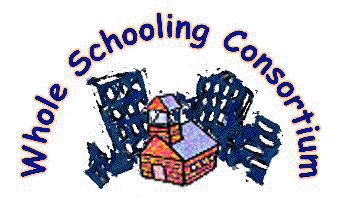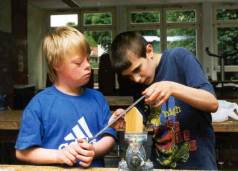

For a democracy to function, by definition, all children must be there. For students to learn well, to be prepared to function in a diverse society, they must be exposed to people with diverse characteristics. Thus, we seek schools in which All children learn together across culture, ethnicity, language, ability, gender, & age, where separate pull-out programs and ability grouping in the classroom are used seldom if at all.Links. Publications.
 CREATING
AN INCLUSIVE COMMUNITY OF LEARNERS:
CREATING
AN INCLUSIVE COMMUNITY OF LEARNERS:
Being
serious about democracy and learning for all.
Segregation and isolation create many problems for many students in schools.
Low income minority students in urban areas are at higher risk for referral
for special education and alternative schools are used for an increasing
number of
students who are considered have behavioral problems and are socially maladjusted.
The President’s Commission on Excellence in Special Education (2002)
found substantive problems with the segregation of students with disabilities.
One
key finding was stated as follows (p. 42):
… This Commission . . . is deeply concerned that many children with severe disabilities, including those children with autism or emotional disturbance, are relegated to segregated educational settings simply because of their disability. Despite decades of successful inclusion of children with disabilities in regular schools . . . , there are children with disabilities who are still segregated simply because their disability creates difficulties in providing integrated educational experiences…
The Commission
further directly stressed educating all students within general education
settings, including those with severe disabilities.
Major Recommendation 3: Consider children with disabilities as general
education children first: Special education and general education are treated
as separate
systems, but in fact share responsibility for the child with disabilities.
In instruction, the systems must work together to provide effective teaching
and
ensure that those with additional needs benefit from strong teaching and
instructional methods that should be offered to a child through general
education. (p. 8)
Overrepresentation
of students of color in special education, has been relatedly recognized
as a critical issue, a factor crucial in urban
areas.
Losen and
Orfield’s
recent edited book (2002) clearly describes these patterns. As indicated
in the figure, Black students are three times as likely to be labeled as
having
mental
retardation and twice as likely to be labeled emotional disturbed than
white students while far fewer such students are identified as gifted and
talented
than expected. Data shows that being served in special education does not
lead to improved outcomes and that minority students are more likely than
white
students to be served in segregated educational settings (Fierros and Conroy,
2002).
For high levels of learning to occur for all students, developing inclusive
classrooms is necessary, not optional. The literature is clear that for
students with and
without disabilities, integrated and inclusive classes are associated
with higher levels of academic achievement (Baker, Wang & Walberg,
1994; Moore, Gilbreath & Maiuri,
1998; Peterson & Hittie, 2003) . Orfield and Gordon (2001) note that
for students to become effective leaders in a multi-cultural society,
schooling must
provide opportunities to engaging students with diverse racial, ethnic
and ability characteristics. The sense of community and social safety
promoted in inclusive
classes, respect for diverse abilities and characteristics, provides
an emotional foundation that allows brain functioning at the highest
levels, preventing the
downward shifts when fear and rejection are prevalent. Diversity represented
in inclusive classrooms provides a stimulus and challenge to deep thinking
that occurs less in segregated classes (McLaughlin & Rouse, 2000).
When a school commits to a new way of thinking and doing however, staff together make a commitment that all students should be welcomed into the school and that teachers and other staff will work to have inclusive classes, heterogeneously grouped where students who are gifted through severely disabled learn, play, and work together.
For this to occur and become part of the culture of the school, the total staff must be committed to this as a value for children, be able to articulate the reasons for their belief, be willing to defend this practice against detractors, and be willing to struggle, learn, and seek answers when it doesn’t seem to be working for a particular child.
In most schools, this will mean a shifting special education, gifted, at risk, and other students from separate classes into general education; identifying the students who are presently in separate special education, gifted, or other schools who would typically attend our school and invite them back; and redesigning the role of specialists to provide support for inclusive teaching.
We would not see children in ability groups in class or children with special needs (learning disabilities, gifted, etc.) clustered in general education classes.
Michael Peterson, 2005
Booth, Tony and Ainscow, Mel. (1998). From them to us: An international study of inclusion in education. Great Britain: Creative Press and Design.
Fisher, D., Sax, C., Pumpian, I. (1999). Inclusive high schools: Learning from contemporary classrooms. Baltimore: Paul H. Brookes.
Kennedy, C. & Fisher, D. (2001). Inclusive middle schools. Baltimore: Paul Brookes Publishing.
Lipsky, D. & Gartner, A. (1997). Inclusion and school reform: Transforming America's classrooms. Baltimore, Maryland: Paul H. Brookes.
McGregor, G. & Vogelsberg, T. (1998). Inclusive schooling practices: Pedagogical and research foundations: A synthesis of the literature that informs best practices about inclusive schooling. Baltimore: Paul H. Brookes.
Stainback, S. & Stainback, W. (1994). Inclusion: A guide for educators. Baltimore, Maryland: Paul H. Brookes.
Peterson, M. & Hittie, M. (2003). Inclusive teaching: Creating effective schools for all learners. Boston: Allyn and Bacon.
Sapon-Shevin, M. (1994b). Playing favorites: Gifted education and the disruption of community. Albany: State University of New York Press.
Villa, R. & Thousand, J. (1996) Creating the inclusive school. Alexandria, Virginia: Assocation for Supervision and Curriculum Development (ASCD).
Villa, R., Thousand, J., Stainback, W. & Stainback, S. (Eds.). (1992). Restructuring for caring and effective education: An administrative guide for creating heterogenous schools. Baltimore: Paul H. Brookes.